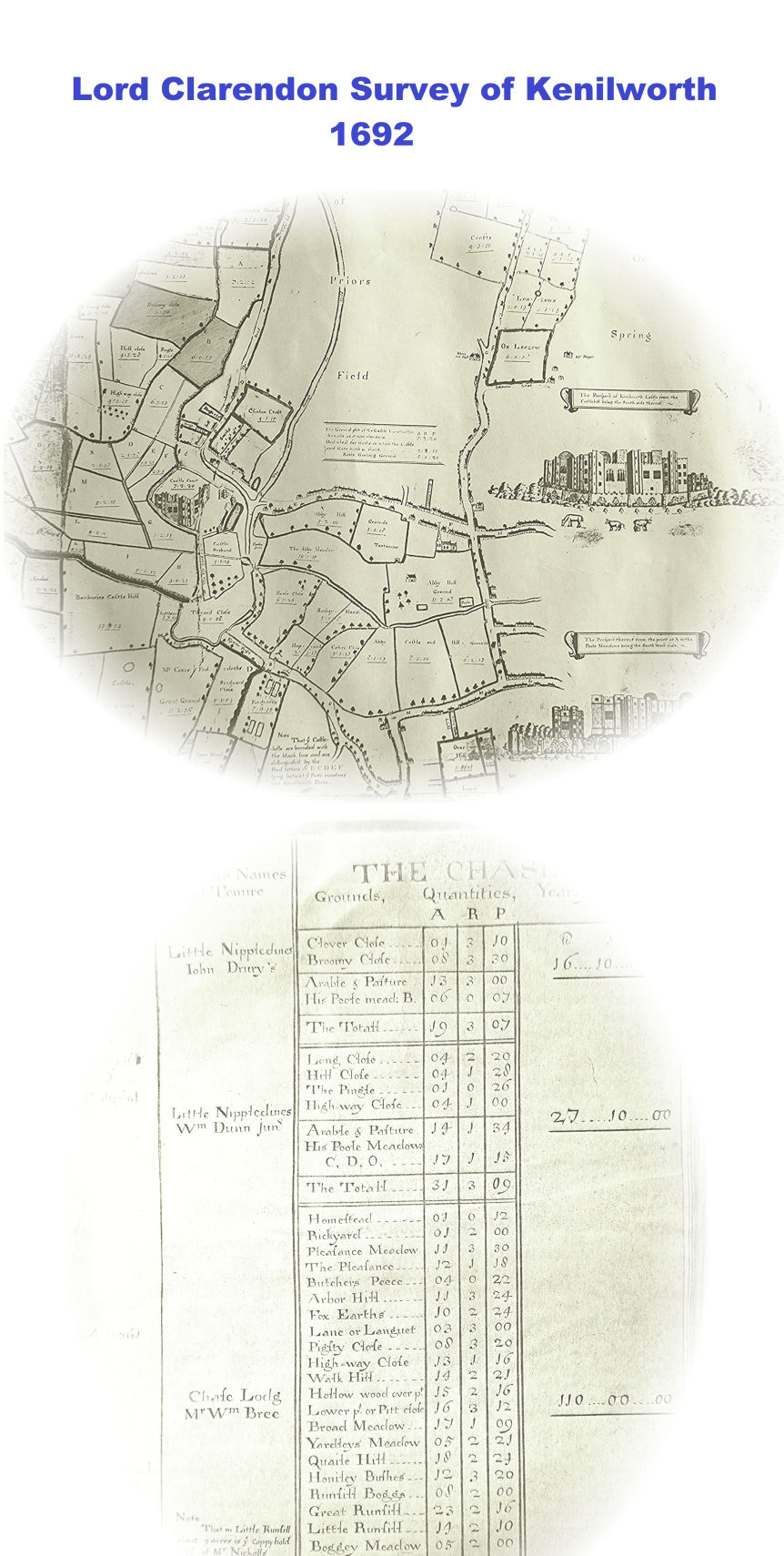John Drury
b. 1656 d. 1730
(Back to Father)
The eldest son of Joseph and Alice was John Drury. He was christened on 8th. May 1656 at St. Nicholas Church Kenilworth (Ref:5).
The vicar of Kenilworth mentions in his long text, the various owners of the Manor of Kenilworth and that he had a long dispute with the Lady of the Manor, Lady Countess Dowager of Denbigh. Having read the vicar's account it is then somewhat disconcerting to find that a survey of the manor in 1692 was carried out by Earl Clarendon, a figure who is never mentioned by the vicar. The explanation is that the manor formed part of the estates of Lord Cary, Earl of Monmouth, granted to him from King Charles I. Upon his death this estate passed to his daughters, who subsequently sub-let it to Earl of Clarendon.
The survey (Ref:38) is contained in a bound volume in which is listed all the tenants of the manor and the properties they owned or leased. Accompanying the listing is an extremely large map, drawn on sown calf-skin, showing the whole of the manor and the properties listed. The map is extremely well illustrated and coloured, and remarkably well preserved for its age.
In the extract from Earl Clarendon's Survey in 1692, John Drury is shown leasing land in "The Chase' in an area known as 'Little Nippledines'. The total area leased was 19 acres 3 Rods and 7 perches, and was rented for £16: 10s: 0d per year. The land he rented is shown on the Survey Map which contains some detailed illustrations. It is interesting to note that the illustrations of the castle show it intact, whereas by 1692 it had been a ruin for more than thirty years. The areas marked A to P are the pastures gained by Capt. Hawkesworth and his Cromwell soldiers when they drained the Great Lake around the Castle, and it is worth noting that John is shown leasing one of these pastures. Perhaps this area was also farmed by his soldier father, obtaining his lease because of his Parliamentarian connections?
Several sets of documents, mostly to do with taxation of one type or another, give lists of owners or tenants. One such set is that of the Land Tax Assessments, which were nationwide taxes concerned mainly with establishing the right to vote. These give lists of the owners of property in a parish, and the 1724 Land Tax Assessment notes several of the Drury Family owning land in the parish of Kenilworth (Ref:48). John Drury was one of those mentioned, and he is listed as paying 5s.0d. for the property or land he owned.
Another record was the more local record, carried out in most parishes, which listed the occupiers of property, rather than the owners. This was known as the Chief Rents, which were equivalent to the present day Council Tax. In the Chief Rents of Kenilworth for the years 1716 and 1721 John Drury is shown as a freeholder and paying 'rates' on at least two properties (Ref:52) .
John is also known to have leased land from the Church Wardens on a 21 year lease, commencing in 1697. This lease is listed at the C.R.O. as being deposited in the strong room at St. Nicholas Church Kenilworth. Unfortunately, its current whereabouts are unknown as there is no record of it at St. Nicholas Church or at the C.R.O., and sadly it probably no longer exists.
On 3rd. October 1686 John married Lydia Hill, from Warwick (Ref:12). Lydia was born in 1666 to Daniel Hill and Maiea Thomas.
Her grandparents were John Hill (b. 1595c) and An Gardoner. Her date of death is unknown, although it is known that she lived longer than her husband,
John, who died on 8th. October 1730,aged 74 (Ref:19) . Lydia is recorded in a survey taken by Earl Clarendon in 1734 (Ref:42) of the tenants of the Manor of Kenilworth. The entry reads:
"Lydia Drury - tenant at will for a term of many years of certain meadows and closes bordering on The Nippledines containing about 40 acres in all."
The land referred to is almost certainly the same land that John was farming, shown on the map, and the tenancy transferred to her upon his death.
At the time of John's death, the woollen industry was under threat from imported goods from abroad and several Acts had been passed to limit imports and increase usage of wool throughout the country. In I721 the wool manufacturers tried to block the import of cotton cloth. Parliament passed an Act to keep finished material out of the country, but raw cotton was imported in ever increasing quantities. The problem was not new and as far back as 1678 an Act to promote wool usage was introduced in which it was necessary to bury corpses in a woollen shroud, coffin burials being uncommon until the late 18th century. In the burial register of St.Nicholas Church Kenilworth there are present signed affidavits showing that those buries at that time were buried in wool. One such affidavit is for John Drury (Ref:19)
John married Lydia Hill from Warwick at St.Nicholas Church Kenilworth on 3rd. October 1686 (Ref:12)
Joseph (c.16/10/1687) (m.n/k) (d.29/01/1746)
John (c.20/02/1688) (m.n/k) (d.n/k)
Patience (c.01/09/1691) (m.n/k) (d.n/k)
Daniel (c.02/02/1696) (m.n/k) (d.12/09/1717)
Benjamin (c.02/02/1698) (m.n/k) (d.21/10/1745?)
Elizabeth* (c.20/02/1700) (m.30/05/1724) (d.16/01/1789)
Robert** (c.14/11/1703) (m.n/k) (d.31/03/1748)
Joanna (c.10/05/1706) (m.n/k) (d.31/03/1707)
Joanna (c.08/08/1708) (m.n/k) (d.n/k)
James (c.18/01/1710) (m.n/k) (d.n/k)
* Elizabeth married William Garlick (b.1681 d.1774) in 1724 and they had 5 children - see Elizabeth Drury / William Garlick Tree
** Robert is thought not to have married and spent his life farming the area around Kenilworth. He is shown in the Kenilworth Augmentation as paying a charge of 0s. 4d. for land rented in 1746 (Ref:49)
